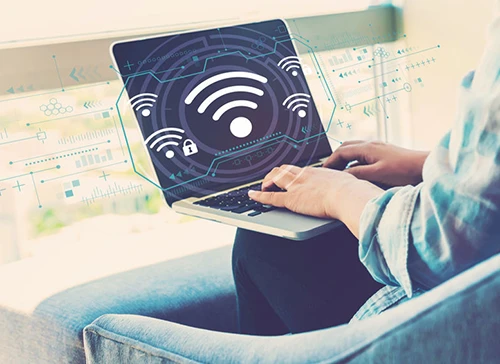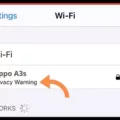We’ve all been there, stuck at home with a painfully slow wifi connection that won’t let you do anything but stare at the wall in frustration. Unfortunately, slow wifi is a common problem that many of us face on a regular basis. Whether it’s due to poor signal strength, interference from other devices, or a weak router, bad wifi can be an extremely frustrating experience.
Fortunately, there are several ways to fix it and get your connection up and running again. Here are some tips for improving your wifi connection:
1. Check the position of your router – A bad wifi signal can be caused by the positioning of your router. If your router is near walls or large objects like furniture, that could block the signal and reduce its strength. Therefore try moving it away from these objects and closer to where you use it most often to get better coverage.
2. Update your router – Outdated routers can cause slow speeds, so make sure that you’re running the latest firmware version available for your device.
3. Change channels – Most routers have multiple channels that they broadcast on; if too many people on your network are broadcasting on the same channel then interference can occur which causes slower speeds and poor connections. Try switching between different channels to see if this helps improve the speed of your connection.
4. Get a new antenna – Some routers come with removable antennas which can be replaced with higher-gain antennas for better performance. If you think this might help in improving your signal strength then look into getting an external antenna for better coverage in hard-to-reach areas of your house or office space.
5. Consider buying a new router – If none of the above tips work then it might be time to invest in a new router; newer models typically come with more features like dual-band support (which allows them to broadcast both 2GHz and 5GHz signals) as well as updated firmware which can help improve performance overall..
6 . Use extenders or repeaters – Extenders or repeaters are devices that amplify wifi signals so that they reach further distances and penetrate walls better than normal routers do; these devices are easy to install and work well when used in combination with an existing wireless network setup..
7 . Get an internet speed test – The last step is to make sure that you’re actually getting what you pay for from your ISP; run an internet speed test such as Speedtest dot net or use an app such as Speedtest by Ookla (available for iOS and Android) to check how fast your download/upload speeds really are.
By following these tips, you should be able to identify where the problem lies and take steps toward fixing it quickly!

Troubleshooting Poor Wi-Fi Performance
To fix bad Wi-Fi, there are a few steps you can take. First, make sure your router is up to date with the latest firmware. Many routers have an auto-update feature that can be enabled so that your router will always stay up to date. Next, check the location of your router. Make sure it’s not blocked or hidden behind furniture or other objects which could cause interference and weaken the signal. You could also consider buying a WiFi extender or range booster to increase your coverage area and give you a stronger signal in areas further away from the router. Finally, make sure that no one else is using bandwidth-heavy applications on their own devices which could be slowing your connection down. If all else fails, you may need to contact your ISP for assistance with improving your connection speed and strength.
Diagnosing Poor Wi-Fi Performance
There are a number of potential reasons why your Wi-Fi connection could be slow or unreliable. The most common cause is interference, which can be caused by a variety of factors such as other networks in the vicinity, physical obstructions like walls or furniture, and outdated hardware. Another possible cause is inadequate bandwidth – if you have multiple users sharing the same network, they may be consuming more data than your router can handle. Additionally, if your router is old or low-end, it may not have the capacity to provide the fast speeds that modern devices require. Finally, if you are connecting to a public network or a neighbor’s Wi-Fi, then you may be experiencing slow speeds due to congestion.
Investigating Poor Wi-Fi Performance on a Device
There could be several reasons why your Wi-Fi connection is slow on your device. First, check the signal strength of the Wi-Fi network you are connected to and make sure it is strong enough to provide a reliable connection. If the signal strength is low, you may need to move closer to the router or find another access point with a stronger signal.
You should also check if there are too many devices connected to your network, as this might be causing congestion and slowing down the connection speed. Additionally, look at any apps running in the background that might be using up bandwidth, and disable them if necessary. Finally, make sure that all of your Wi-Fi settings are correct, as incorrect settings can affect your connection speeds.
Signs of Poor Wi-Fi Performance
If you suspect that your Wi-Fi connection is bad, the best way to verify this is to run a speed test. You can do this on a computer by going to Speedtest.net, or you can download and run the Speedtest app (iOS, Android) on a phone or tablet. Make sure that you’re using your Wi-Fi rather than cellular data and that any VPNs are disconnected.
Once you’ve run the test, check the results for your download speed, upload speed, and ping (latency). If any of these values are significantly lower than what is advertised by your internet service provider (ISP), then it’s likely that your Wi-Fi connection is poor. Additionally, if browsing websites or streaming videos feels slow or choppy, then it’s likely that there are issues with your Wi-Fi connection.
Understanding the Causes of Weak Wi-Fi in the Home
There are several possible reasons why your Wi-Fi may be weak in your house. It could be that the router is too far away from all of the devices you’re trying to connect with it. If there are thick walls, floors, or other large appliances between the router and the device, this can also significantly reduce the signal strength. Additionally, if too many people and devices are connected to one network this can quickly overwhelm it, reducing its performance. To check if any of these issues are causing your Wi-Fi to be weak, try moving your router closer to your devices and/or disconnecting some of the devices on your network.
Decrease in Wi-Fi Performance Without Warning
There are a few possible reasons why your Wi-Fi may have suddenly become slower. It could be that there are too many devices connected to your router, or that one of them is draining too much bandwidth with activities like video streaming or online gaming. It could also be that your router’s signal strength is lower than it was before. Lastly, it could be that you’re experiencing interference from another device in the area, such as a microwave or baby monitor. To help determine which of these factors is causing the issue, try temporarily disconnecting some of the devices connected to your router and see if that helps your speeds improve.
Common Issues Encountered with Wi-Fi
The most common Wi-Fi problems include slow speeds, weak signals, interference from other devices, outdated equipment, incorrect settings and configuration, and incorrect password authentication. Slow speeds are often caused by too many users connecting to the same router or a weak signal originating from the router. Weak signals can also be caused by physical obstructions such as walls or furniture that block the signal. Interference from other devices such as microwaves, baby monitors, or Bluetooth speakers can also affect Wi-Fi connectivity. Outdated equipment may not support newer technology standards such as 802.11ac. Incorrect settings and configurations may cause routers to become unresponsive or unstable. Finally, incorrect password authentication can prevent users from connecting to the network altogether.
Conclusion
In conclusion, poor wifi can be a major problem. It can lead to poor connection speeds, slow loading times, and even an inability to access the internet at all. If you are experiencing any of these issues, it is important to identify the cause and find a solution. This could include getting a modern router, buying a wifi extender, checking for router updates, using a long-range router, or performing a speed test. By taking the necessary steps to improve your wifi connection speed and reliability, you can enjoy a better internet experience.








